torque Oldsmobile Achieva 1998 Owner's Manuals
[x] Cancel search | Manufacturer: OLDSMOBILE, Model Year: 1998, Model line: Achieva, Model: Oldsmobile Achieva 1998Pages: 356, PDF Size: 18.04 MB
Page 89 of 356
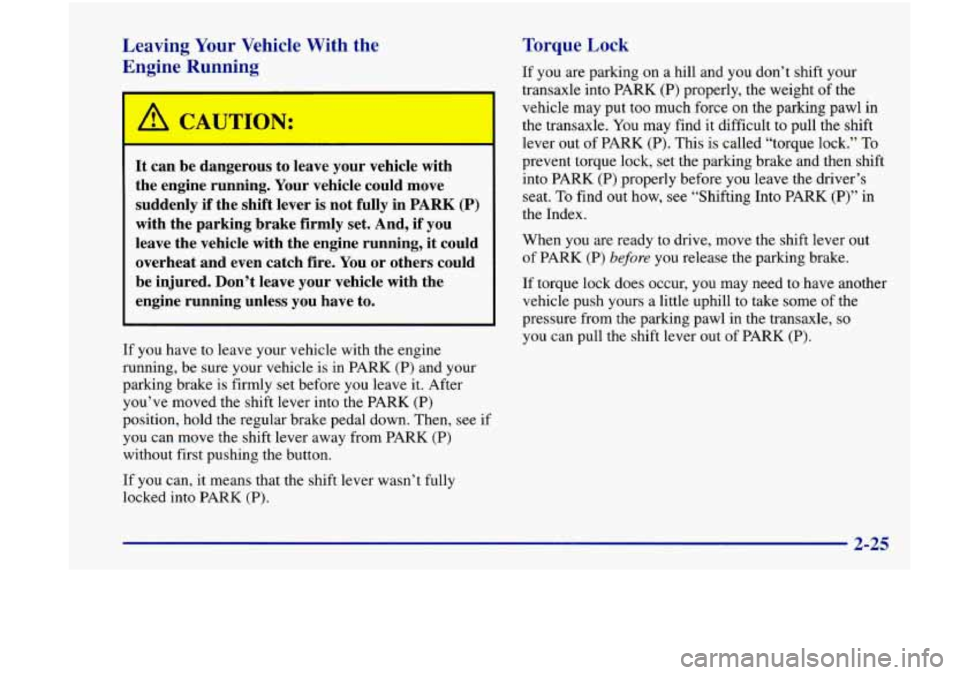
Leaving Your Vehicle With the
Engine Running
It can be dangerous to leave your vehicle with
the engine running. Your vehicle could move
suddenly if the shift lever is not fully in PARK
(P)
with the parking brake firmly set. And, if you
leave the vehicle with the engine running, it could
overheat and even catch fire. You or others could
be injured. Don’t leave your vehicle with the
engine running unless you have to.
If you have to leave your vehicle with the engine
running, be sure your vehicle is in PARK
(P) and your
parking brake is firmly set before you leave it. After
you’ve moved the shift lever into the PARK
(P)
position, hold the regular brake pedal down. Then, see if
you can move the shift lever away from PARK (P)
without first pushing the button.
If you can, it means that the shift lever wasn’t fully
locked into PARK
(P).
Torque Lock
If you are parking on a hill and you don’t shift your
transaxle into PARK (P) properly, the weight of the
vehicle may put too much force on the parking pawl in
the transaxle. You may find it difficult to pull the shift
lever out of PARK
(P). This is called “torque lock.” To
prevent torque lock, set the parking brake and then shift
into
PARK (P) properly before you leave the driver’s
seat. To find out how,
see “Shifting Into PARK (P)” in
the Index.
When you are ready to drive, move the shift lever out
of PARK (P) before you release the parking brake.
If torque lock does occur, you may need to have another
vehicle push yours a little uphill to take some of the
pressure from the parking pawl in the transaxle,
so
you can pull the shift lever out of PARK (P).
Page 221 of 356
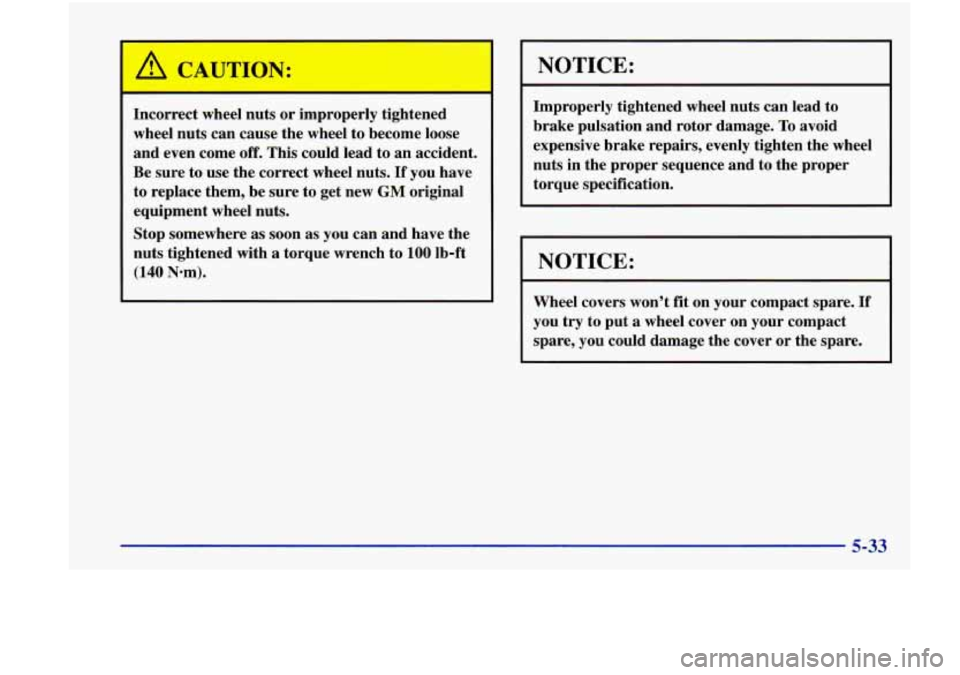
1. C! UTldN:
Incorrect wheel nuts or improperly tightened
wheel nuts can cause the wheel to become loose
and even come
off. This could lead to an accident.
Be sure to use the correct wheel nuts.
If you have
to replace them, be sure to get new
GM original
equipment wheel nuts.
Stop somewhere
as soon as you can and have the
nuts tightened with
a torque wrench to 100 lb-ft
(140 N-m).
NOTICE:
Improperly tightened wheel nuts can lead to
brake pulsation and rotor damage.
To avoid
expensive brake repairs, evenly tighten the wheel
nuts in the proper sequence and to the proper
torque specification.
I NOTICE: I
Wheel covers won’t fit on your compact spare. If
you try to put a wheel cover on your compact
spare, you could damage the cover or the spare.
Page 258 of 356
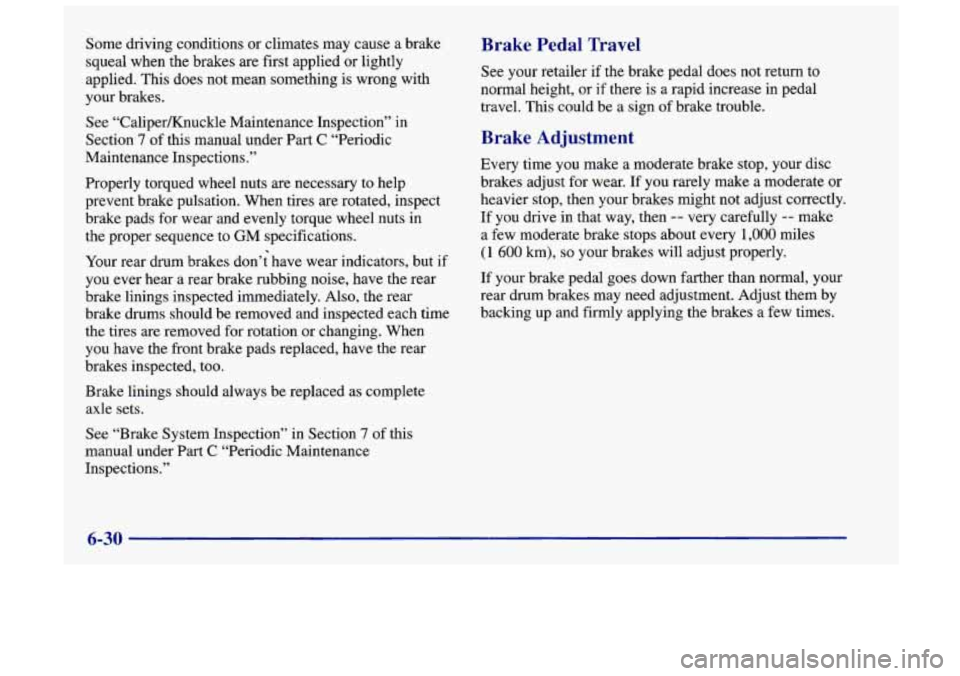
Some driving conditions or climates may cause a brake
squeal when the brakes are first applied or lightly
applied. This does not mean something
is wrong with
your brakes.
See “CaliperKnuckle Maintenance Inspection” in
Section
7 of this manual under Part C “Periodic
Maintenance Inspections.”
Properly torqued wheel nuts are necessary to help
prevent brake pulsation. When tires
are rotated, inspect
brake pads for wear and evenly torque wheel nuts in
the proper sequence to GM specifications.
Your rear drum brakes don’; have wear indicators, but if
you ever hear a rear brake rubbing noise, have the rear
brake linings inspected immediately. Also, the
rear
brake drums should be removed and inspected each time
the tires
are removed for rotation or changing. When
you have the front brake pads replaced, have the rear
brakes inspected, too.
Brake linings should always be replaced as complete
axle sets.
See “Brake System Inspection” in Section
7 of this
manual under Part
C “Periodic Maintenance
Inspections.”
Brake Pedal Travel
See your retailer if the brake pedal does not return to
normal height, or
if there is a rapid increase in pedal
travel.
This could be a sign of brake trouble.
Brake Adjustment
Every time you make a moderate brake stop, your disc
brakes adjust for wear.
If you rarely make a moderate or
heavier stop, then your brakes might not adjust correctly.
If you drive in that way, then
-- very carefully -- make
a few moderate brake stops about every
1,000 miles
(1 600 km), so your brakes will adjust properly.
If your brake pedal goes down farther than normal, your
rear drum brakes may need adjustment. Adjust them by
backing up and firmly applying the brakes a few times.
6-30
Page 267 of 356
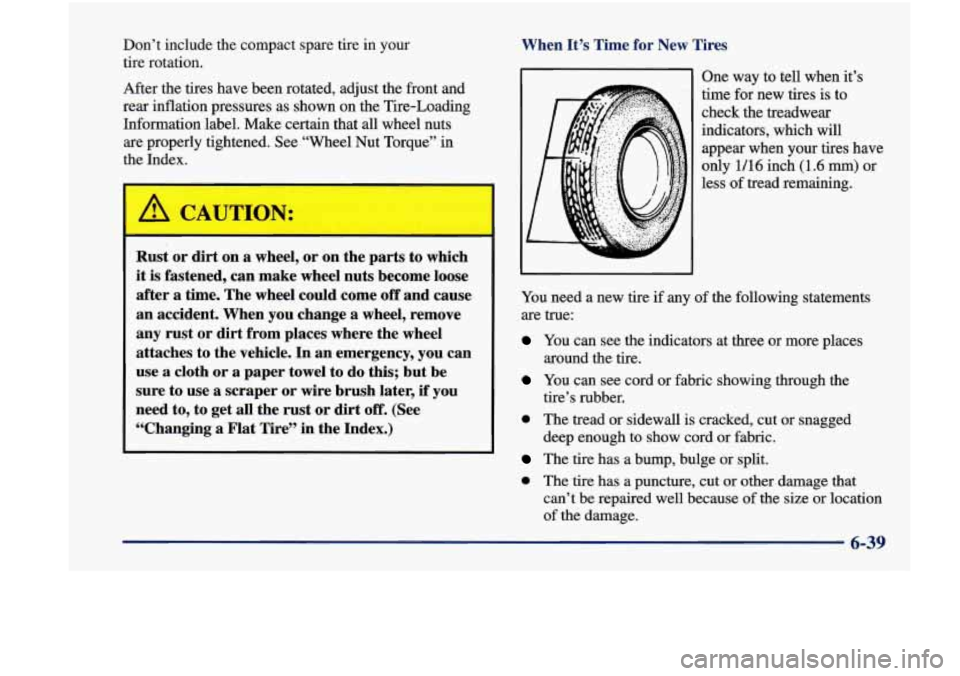
When It’s Time for New Tires Don’t include the compact spare tire in your
tire rotation.
After the tires have been rotated, adjust the front and
rear inflation pressures as shown on the Tire-Loading
Information label. Make certain that
all wheel nuts
are properly tightened. See “Wheel Nut Torque” in
the Index.
Rust or dirt on a wheel, or on the parts to which
it is fastened, can make wheel nuts become loose
after
a time. The wheel could come off and cause
an accident. When you change a wheel, remove
any rust or dirt from places where the wheel
attaches to the vehicle. In an emergency, you can
use a cloth
or a paper towel to do this; but be
sure to
use a scraper or wire brush later, if you
need to, to get
all the rust or dirt off. (See
“Changing
a Flat Tire” in the Index.)
One way to tell when it’s
time for new tires is to
check the treadwear
indicators, which will
appear when your tires have
only
1/16 inch (1.6 mm) or
less of tread remaining.
You need a new tire
if any of the following statements
are true:
You can see the indicators at three or more places
around the tire.
You can see cord or fabric showing through the
tire’s rubber.
0 The tread or sidewall is cracked, cut or snagged
The tire has a bump, bulge or split.
0 The tire has a puncture, cut or other damage that
deep
enough to show cord or fabric.
can’t be repaired well because of the size or location
of the damage.
6-39
Page 286 of 356
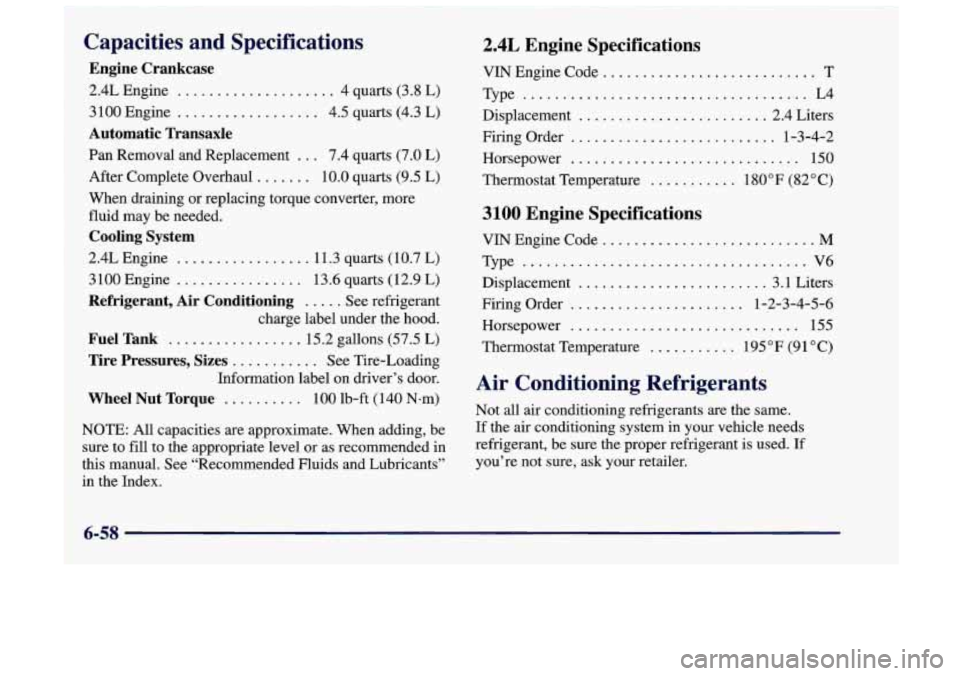
Capacities and Specifications
Engine Crankcase
2.4L Engine .................... 4 quarts (3.8 L)
3 100 Engine .................. 4.5 quarts (4.3 L)
Automatic Transaxle
Pan Removal and Replacement ... 7.4 quarts (7.0 L)
After Complete Overhaul
....... 10.0 quarts (9.5 L)
When draining or replacing torque converter, more
fluid may be needed.
Cooling System
2.4L Engine ................. 11.3 quarts (10.7 L)
3100 Engine
................ 13.6 quarts (12.9 L)
Refrigerant, Air Conditioning ..... See refrigerant
charge label under the hood.
Fuel Tank ................. 15.2 gallons (57.5 L)
Tire Pressures, Sizes ........... See Tire-Loading
Information label on driver’s door.
Wheel Nut Torque .......... 100 lb-ft (140 N-m)
NOTE: All capacities are approximate. When adding, be
sure to fill to the appropriate level or as recommended
in
this manual. See “Recommended Fluids and Lubricants”
’ in the Index.
2.4L Engine Specifications
VIN Engine Code ........................... T
Type
.................................... L4
Displacement
........................ 2.4 Liters
Firing Order
.......................... 1-3-4-2
Horsepower
............................. 150
Thermostat Temperature
........... 1 80” F (82 O C)
3100 Engine Specifications
VIN Engine Code ........................... M
Type .................................... V6
Displacement ........................ 3.1 Liters
Firing Order
...................... 1-2-3-4-5-6
Thermostat Temperature
........... 195 O F (9 1 O C)
Horsepower
............................. 155
Air Conditioning Refrigerants
Not
all air conditioning refrigerants are the same.
If the air conditioning system in your vehicle needs
refrigerant, be sure the proper refrigerant is used.
If
you’re not sure, ask your retailer.
Page 352 of 356
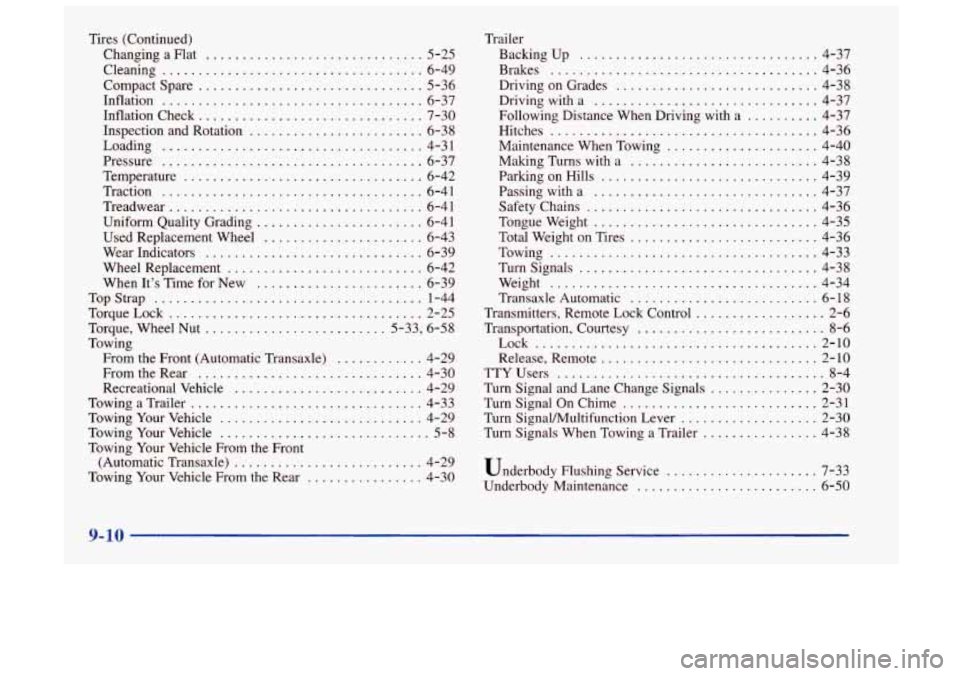
Tires (Continued)
Changing a Flat
.............................. 5-25
Compact Spare
............................... 5-36
Cleaning
.................................... 6-49
Inflation
.................................... 6-37
Inflation Check
............................... 7-30
Inspection and Rotation
........................ 6-38
Loading
.................................... 4-31
Pressure
.................................... 6-37
Temperature
................................. 6-42
Traction
.................................... 6-41
Treadwear
................................... 6-41
Uniform Quality Grading
....................... 6-41
Used Replacement Wheel
...................... 6-43
Wear Indicators
.............................. 6-39
Wheel Replacement
........................... 6-42
When It’s Time for New
....................... 6-39
TopStrap
..................................... 1-44
TorqueLock
................................... 2-25
Torque, Wheel Nut
......................... 5-33. 6-58
Towing
From the Front (Automatic Transaxle)
............ 4-29
From the Rear
............................... 4-30
Recreational Vehicle
.......................... 4-29
Towing a Trailer
................................ 4-33
Towing Your Vehicle
............................ 4-29
Towing Your Vehicle
............................. 5-8
Towing Your Vehicle From the Front
(Automatic Transaxle)
.......................... 4-29
Towing
Your Vehicle From the Rear ................ 4-30 Trailer
Backingup
................................. 4-37
Brakes
..................................... 4-36
Driving on Grades
............................ 4-38
Driving with a
............................... 4-37
Following Distance When Driving with a
.......... 4-37
Hitches
..................................... 4-36
Maintenance When Towing
..................... 4-40
Making Turns with a
.......................... 4-38
Parking on Hills
.............................. 4-39
Passing with a
............................... 4-37
Safety Chains
................................ 4-36
Tongueweight
............................... 4-35
Total Weight on Tires
.......................... 4-36
Towing
..................................... 4-33
Turnsignals
................................. 4-38
Weight
..................................... 4-34
Transaxle Automatic
.......................... 6-18
Transmitters. Remote Lock Control
.................. 2-6
Transportation. Courtesy
.......................... 8-6
Lock ....................................... 2-10
Release. Remote
.............................. 2-10
TTYUsers
..................................... 8-4
Turn Signal and Lane Change Signals
............... 2-30
Turn Signal On Chime
........................... 2-31
Turn Signalhlultifunction Lever
................... 2-30
Turn Signals When Towing a Trailer
................ 4-38
Underbody Flushing Service
..................... 7-33
Underbody Maintenance
......................... 6-50
9-10
Page 353 of 356
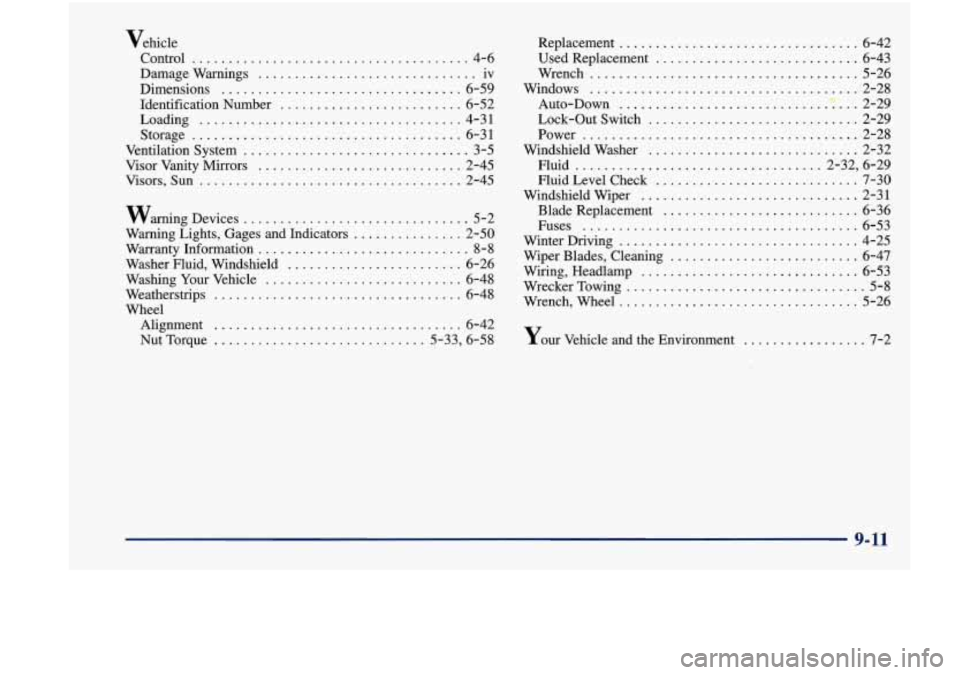
Vehicle Control
...................................... 4-6
Damage Warnings
.............................. iv
Dimensions
................................. 6-59
Identification Number
......................... 6-52
Loading
.................................... 4-31
Storage
..................................... 6-31
Ventilation System
............................... 3-5
Visor Vanity Mirrors
............................ 2-45
Visors. Sun
.................................... 2-45
warning Devices
............................... 5-2
Warning Lights. Gages and Indicators
............... 2-50
Warrantyhformation
............................. 8-8
Washer Fluid. Windshield ........................ 6-26
Washing Your Vehicle
........................... 6-48
Weatherstrips
.................................. 6-48
Wheel Alignment
.................................. 6-42
Nut Torque
............................. 5-33. 6-58 Replacement
................................. 6-42
Used Replacement
............................ 6-43
Wrench
..................................... 5-26
Windows
..................................... 2-28
Auto-Down
................................. 2-29
Lock-Out Switch
............................. 2-29
Power
...................................... 2-28
Windshield Washer
............................. 2-32
Fluid
.................................. 2.32. 6.29
HuidLevelCheck
............................ 7-30
Windshield Wiper
.............................. 2-31
Blade Replacement
........................... 6-36
Fuses
...................................... 6-53
Wiper Blades. Cleaning
.......................... 6-47
Wiring. Headlamp
.............................. 6-53
WreckerTowing
................................. 5-8
Wrench. Wheel
................................. 5-26
Winter
Driving
................................. 4-25
Your Vehicle and the Environment
................. 7-2
9-11